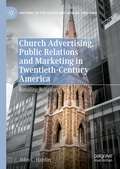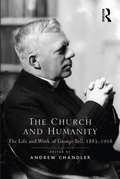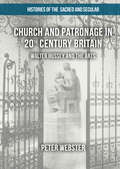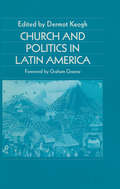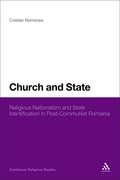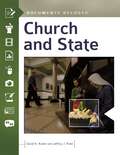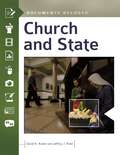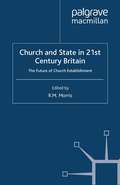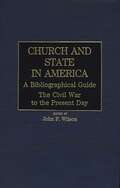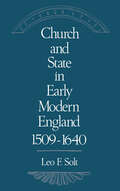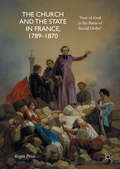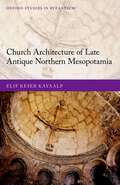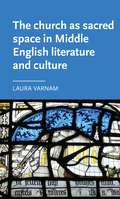- Table View
- List View
Church 3.0: Upgrades for the Future of the Church (Jossey-Bass Leadership Network Series #49)
by Neil ColeAn expert practitioner answers to questions about the burgeoning organic church movement Neil Cole's best-selling book Organic Church described the fastest growing segment of contemporary Christianity-the so-called organic church. Now in this next-step book, he answers questions about how to deal with theological and organizational issues that come up. He talks about issues such has what to do with finances, children, heresy, leader training, and rituals and ordinances. Without the top-down structure of a denomination, even people who are proponents of this small, house-church model worry that they are not doing it right. Offers an important resource for anyone involved with or thinking of starting an organic or house church Addresses practical issues of theology, rituals, doctrinal heresy, how to handle children, finances, and other important questions Written by an acknowledged expert who is now and has been for over twenty years an organic church planter and practitioner A new Leadership Network title and follow-up to Organic Church Church 3.0 offers solid information about organic churches based on Cole's extensive experience in starting, nurturing, and mentoring in the organic church movement.
Church 3.0: Upgrades for the Future of the Church (Jossey-Bass Leadership Network Series #49)
by Neil ColeAn expert practitioner answers to questions about the burgeoning organic church movement Neil Cole's best-selling book Organic Church described the fastest growing segment of contemporary Christianity-the so-called organic church. Now in this next-step book, he answers questions about how to deal with theological and organizational issues that come up. He talks about issues such has what to do with finances, children, heresy, leader training, and rituals and ordinances. Without the top-down structure of a denomination, even people who are proponents of this small, house-church model worry that they are not doing it right. Offers an important resource for anyone involved with or thinking of starting an organic or house church Addresses practical issues of theology, rituals, doctrinal heresy, how to handle children, finances, and other important questions Written by an acknowledged expert who is now and has been for over twenty years an organic church planter and practitioner A new Leadership Network title and follow-up to Organic Church Church 3.0 offers solid information about organic churches based on Cole's extensive experience in starting, nurturing, and mentoring in the organic church movement.
Church Advertising, Public Relations and Marketing in Twentieth-Century America: Retailing Religion (Histories of the Sacred and Secular, 1700–2000)
by John C. HardinThis book examines the complex relationship between religion and business in twentieth-century America. It is the story of how Christianity’s most basic institution, the local church, wrestled with the challenges and compromises of competing in the modern marketplace through adopting the advertising, public relations, and marketing methods of business. It follows these sacred promoters, and their critics, as they navigated between divinely inspired and consumer demanded. Amid an animated and contentious battleground for principles, practices and parishioners, John C. Hardin explores the landscape of selling religion in America and its evolution over the twentieth century.
Church After the Corona Pandemic: Consequences for Worship and Theology
by Kyle K. Schiefelbein-GuerreroThis book explores the church's engagement with worship and theology as a result of the pandemic, especially as it relates to digital worship and the means of grace. Organized around the four-fold pattern of Sunday worship—Gathering, Word, Meal, Sending—this collection of essays provides source material for both theological discernment and practical implementation. Topics include preparing and theologizing worship no matter the modality, engaging the questions of embodiment as related to the incarnation of Christ, and looking at the theology of church in a digital age. Renowned scholars in the field explore how online worship provides for the visibility of the gospel, how to lament and pray in the midst of pandemic and future crises, and how the mission of the church through its worship can continue regardless of physical restrictions. This timely collection appeals to researchers, professionals, and practitioners in the field.
The Church and Employment Law: A Comparative Analysis of The Legal Status of Clergy and Religious Workers (ICLARS Series on Law and Religion)
by John DuddingtonThis book examines the current law on the employment status of ministers of religion together with religious workers and volunteers and suggests reforms in this area of the law to meet the need for ministers to be given a degree of employment protection. It also considers the constant theme in Christian history that the clergy should not be subject to the ordinary courts and asks whether this is justified with the growth of areas such as employment law. The work questions whether it is possible to arrive at a satisfactory definition of who is a minister of religion and, along with this, who would be the employer of the minister if there was a contract of employment. Taking a comparative perspective, it evaluates the case law on the employment status of Christian and non-Christian clergy and assesses whether this shows any coherent theme or line of development. The work also considers the issue of ministerial employment status against the background of the autonomy of churches and other religious bodies from the State, together with their ecclesiology. The book will be of interest to academics and researchers working in the areas of law and religion, employment law and religious studies, together with both legal practitioners and human resources practitioners in these areas.
The Church and Employment Law: A Comparative Analysis of The Legal Status of Clergy and Religious Workers (ICLARS Series on Law and Religion)
by John DuddingtonThis book examines the current law on the employment status of ministers of religion together with religious workers and volunteers and suggests reforms in this area of the law to meet the need for ministers to be given a degree of employment protection. It also considers the constant theme in Christian history that the clergy should not be subject to the ordinary courts and asks whether this is justified with the growth of areas such as employment law. The work questions whether it is possible to arrive at a satisfactory definition of who is a minister of religion and, along with this, who would be the employer of the minister if there was a contract of employment. Taking a comparative perspective, it evaluates the case law on the employment status of Christian and non-Christian clergy and assesses whether this shows any coherent theme or line of development. The work also considers the issue of ministerial employment status against the background of the autonomy of churches and other religious bodies from the State, together with their ecclesiology. The book will be of interest to academics and researchers working in the areas of law and religion, employment law and religious studies, together with both legal practitioners and human resources practitioners in these areas.
The Church and Humanity: The Life and Work of George Bell, 1883–1958
by Andrew ChandlerGeorge Bell remains one of only a handful of twentieth-century English bishops to possess a continuing international reputation for his involvement in political affairs. His insistence that Christian faith required active participation in public life, at home and abroad, established an eminent, and often provocative, contribution to Christian ethics at large. Bell's participation in the tragic history of the German resistance against Hitler has earned him an enduring place in the historiography of the Third Reich; his February 1944 speech protesting against the obliteration bombing of Germany, made in the House of Lords, is still often considered one of the great prophetic speeches of the twentieth century. Throughout his long career, Bell became a leading light in the burgeoning ecumenical movement, a supporter of refugees from dictatorships of all kinds, a committed internationalist and a patron of the Arts. This book draws together the work of leading international historians and theologians, including Rowan Williams, and makes an important contribution to a range of ongoing political, ecumenical and international debates.
The Church and Humanity: The Life and Work of George Bell, 1883–1958
by Andrew ChandlerGeorge Bell remains one of only a handful of twentieth-century English bishops to possess a continuing international reputation for his involvement in political affairs. His insistence that Christian faith required active participation in public life, at home and abroad, established an eminent, and often provocative, contribution to Christian ethics at large. Bell's participation in the tragic history of the German resistance against Hitler has earned him an enduring place in the historiography of the Third Reich; his February 1944 speech protesting against the obliteration bombing of Germany, made in the House of Lords, is still often considered one of the great prophetic speeches of the twentieth century. Throughout his long career, Bell became a leading light in the burgeoning ecumenical movement, a supporter of refugees from dictatorships of all kinds, a committed internationalist and a patron of the Arts. This book draws together the work of leading international historians and theologians, including Rowan Williams, and makes an important contribution to a range of ongoing political, ecumenical and international debates.
Church and Patronage in 20th Century Britain: Walter Hussey and the Arts (Histories of the Sacred and Secular, 1700–2000)
by Peter WebsterThis book is the first full-length treatment of Walter Hussey's work as a patron between 1943 and 1978, first for the Anglican parish church of St Matthew in Northampton, and then at Chichester Cathedral. He was responsible for the most significant sequence of works of art commissioned for the British churches in the twentieth century. They included music by Benjamin Britten, Leonard Bernstein and William Walton, visual art by Henry Moore, Graham Sutherland and Marc Chagall, and poetry by W. H. Auden. Placing Hussey in theological context and in a period of rapid cultural change, it explores the making and reception of the commissions, and the longer-term influence of his work, still felt today. As well as contributing to the religious and cultural history of Britain, and of Anglo-Catholicism and the cathedrals in particular, the book will be of interest to all those concerned with the relationship between theology and the arts, and to historians of music and the visual arts.
Church and Politics in Latin America (Latin American Studies Series)
by Dermot KeoghComplex and profound changes have been taking place in the Latin American Catholic Church in the 20th century which have often been misunderstood and misrepresented. This is a collection of essays written by scholars working in the fields of history, political science, sociology, law and theology.
Church and Religious 'Other' (Ecclesiological Investigations)
by Gerard MannionThis volume brings together the prestigious speakers at the inaugural Church in Our Times Lecture Series at Liverpool Hope, throughout the first 4 months of 2006, and invited contributors from and addressing wider international contexts - Africa, Sri Lanka, India and the United States. The volume explores themes such as questions of ecclesial and religious identity in these post-modern times, the advent of neo-exclusivism, divisions within the contemporary Roman Catholic and Anglicans churches, inter-faith relations and dialogue, questions of sexuality and Christian ministry, contemporary understandings of ecclesial authority, teaching and tradition, the inter-relation between the church and the kingdom of God today, an Asian appraisal of Pope Benedict's first sermon, inculturation and the rhetoric and reality of the notion of Church as Christianity's most distinctive and defining feature and constructive proposals for ecumenical ways forward in the future. The commonality and coherence of the papers, along with the manner in which a number of them together contribute towards making a cumulative case upon similar issues of concern for the 'church in our times', constitute a major strength of this collection. This volume will interest faculty and students engaged in the study of the contemporary church, ecumenism, global Christianity, secularity and inter-religious dialogue, as well as appealing to ministers and pastors as well as the general reader excited by the most pressing debates pertaining to the church in these times.
Church and State: Religious Nationalism and State Identification in Post-Communist Romania
by Cristian RomoceaTwenty years have passed since the fall of the Iron Curtain, yet emerging democracies continue to struggle with a secular state which does not give preference to churches as major political players. This book explores the nationalist inclinations of an Eastern Orthodox Church as it interacts with a politically immature yet decisively democratic Eastern European state. Discussing the birth pangs of extreme nationalist movements of the twentieth century, it offers a creative retelling of the ideological idiosyncrasies which have characterized Marxist Communism and Nazism. Cristian Romocea provides a constant juxtaposition of the ideological movements as they interacted and affected organized religion, at times seeking to remove it, assimilate it or even imitate it. Of interest to historians, theologians and politicians, this book introduces the reader, through a case study of Romania, to relevant and contemporary challenges churches worldwide are facing in a context characterized by increased secularization of the state and radicalization of religion.
Church and State: Religious Nationalism and State Identification in Post-Communist Romania
by Cristian RomoceaTwenty years have passed since the fall of the Iron Curtain, yet emerging democracies continue to struggle with a secular state which does not give preference to churches as major political players. This book explores the nationalist inclinations of an Eastern Orthodox Church as it interacts with a politically immature yet decisively democratic Eastern European state. Discussing the birth pangs of extreme nationalist movements of the twentieth century, it offers a creative retelling of the ideological idiosyncrasies which have characterized Marxist Communism and Nazism. Cristian Romocea provides a constant juxtaposition of the ideological movements as they interacted and affected organized religion, at times seeking to remove it, assimilate it or even imitate it. Of interest to historians, theologians and politicians, this book introduces the reader, through a case study of Romania, to relevant and contemporary challenges churches worldwide are facing in a context characterized by increased secularization of the state and radicalization of religion.
Church and State: Documents Decoded (Documents Decoded)
by David K. Ryden Jeffrey J. PoletThis thoroughly annotated document collection gives students and researchers an authoritative source for understanding the evolving political and legal relationship between church and state from colonial times to the present day.The First Amendment to the Constitution of the United States declares that "Congress shall make no law respecting an establishment of religion, or prohibiting the free exercise thereof." The Establishment Clause, meanwhile, declares a position of neutrality not only between differing religions, but between religious and nonreligious beliefs. The terms of the Free Exercise Clause, however, provide special protections to religious belief and practice. Thus the provisions of the two clauses can clash. In fact, differing political and legal interpretations of these clauses have resulted in some of the most hard-fought and contentious philosophical battles in American history.This book provides readers with convenient access to pertinent documents and court cases that enables a deeper understanding of the past and current balance between church and state and its political implications in the 21st century. The expert commentary that accompanies these key documents serves to elucidate how interpretation of the U.S. Constitution affects issues such as whether public funds or other public support should go to religious-based schools or hospitals; how to safeguard individuals' rights to religious expression while also considering how individuals should not be forced to participate in mandatory religious expressions in public institutions; and how the language regarding "separation of church and state" came about, when this phrase does not appear anywhere in the Constitution.
Church and State: Documents Decoded (Documents Decoded)
by David K. Ryden Jeffrey J. PoletThis thoroughly annotated document collection gives students and researchers an authoritative source for understanding the evolving political and legal relationship between church and state from colonial times to the present day.The First Amendment to the Constitution of the United States declares that "Congress shall make no law respecting an establishment of religion, or prohibiting the free exercise thereof." The Establishment Clause, meanwhile, declares a position of neutrality not only between differing religions, but between religious and nonreligious beliefs. The terms of the Free Exercise Clause, however, provide special protections to religious belief and practice. Thus the provisions of the two clauses can clash. In fact, differing political and legal interpretations of these clauses have resulted in some of the most hard-fought and contentious philosophical battles in American history.This book provides readers with convenient access to pertinent documents and court cases that enables a deeper understanding of the past and current balance between church and state and its political implications in the 21st century. The expert commentary that accompanies these key documents serves to elucidate how interpretation of the U.S. Constitution affects issues such as whether public funds or other public support should go to religious-based schools or hospitals; how to safeguard individuals' rights to religious expression while also considering how individuals should not be forced to participate in mandatory religious expressions in public institutions; and how the language regarding "separation of church and state" came about, when this phrase does not appear anywhere in the Constitution.
Church and State in 21st Century Britain: The Future of Church Establishment
by R. MorrisWith Church establishment largely locked in the geopolitics of the late 17th century, this study examines the case for change. How should the constitution respond to an ever more pluralized society; what are the implications for the religious character of the monarchy? This book helps readers consider such questions and reach their own judgments.
Church and State in America: The Civil War to the Present Day
by Bloomsbury PublishingThe second in a two-volume bibliography on church-state relations in U.S. history, this book contains eleven critical essays and accompanying bibliographical listings on periods or topics from the Civil War to the present day. Each essay reviews the available relevant literature, and the listings emphasize critical studies and documents published in the last quarter-century. This reference work will enable the reader to grasp the historiographic issues, become acquainted with the resources available, and move on to interpret current as well as past issues more knowledgebly and effectively.
Church and State in Early Modern England, 1509-1640
by Leo F. SoltThe relationship between church and state, indeed between religion and politics, has been one of the most significant themes in early modern English history. While scores of specialized studies have greatly advanced scholars' understanding of particular aspects of this period, there is no general overview that takes into account current scholarship. This volume discharges that task. Solt seeks to provide the main contours of church-state connections in England from 1509 to 1640 through a selective narration of events interspersed with interpretive summaries. Since World War II, social and economic explanations have dominated the interpretation of events in Tudor and early Stuart England. While these explanations continue to be influential, religious and political explanations have once again come to the fore. Drawing extensively from both primary and secondary sources, Solt provides a scholarly synthesis that combines the findings of earlier research with the more recent emphasis on the impact of religion on political events and vice versa.
The Church and the Problem of Divine Hiddenness: Mirrors of God (Routledge Studies in Analytic and Systematic Theology)
by Derek S. KingThis book offers a theological, and more specifically ecclesiological, response to the philosophical problem of divine hiddenness. It engages with philosopher J.L. Schellenberg’s argument on hiddenness and sets out a theologically rich and fresh response, drawing on the ecclesiological thought of Gregory of Nyssa. With careful attention to Gregory’s work, the book shows how certain ecclesiological problems and themes are critical to the hiddenness argument. It looks to the gathered church (the church as the body of Christ) and the scattered church (the church as the image of God) for relevance to the hiddenness problem. The volume will be of interest to scholars of theology and philosophy, particularly analytic theologians and philosophers of religion.
The Church and the Problem of Divine Hiddenness: Mirrors of God (Routledge Studies in Analytic and Systematic Theology)
by Derek S. KingThis book offers a theological, and more specifically ecclesiological, response to the philosophical problem of divine hiddenness. It engages with philosopher J.L. Schellenberg’s argument on hiddenness and sets out a theologically rich and fresh response, drawing on the ecclesiological thought of Gregory of Nyssa. With careful attention to Gregory’s work, the book shows how certain ecclesiological problems and themes are critical to the hiddenness argument. It looks to the gathered church (the church as the body of Christ) and the scattered church (the church as the image of God) for relevance to the hiddenness problem. The volume will be of interest to scholars of theology and philosophy, particularly analytic theologians and philosophers of religion.
The Church and the State in France, 1789-1870: 'Fear of God is the Basis of Social Order'
by Roger PriceThis book explores the responses of the Roman Catholic Church to the French Revolution beginning in 1789, to the liberal revolution in 1830, and particularly the democratic revolution of 1848 in France, and asks how these events were perceived and explained. Informed by the collective memory of the first revolution, how did the Church react to renewed ‘catastrophe’? How did it seek to influence political choice? Why did authoritarian government prove to be so attractive? This is a study of the impact of religion on political behaviour, as well as of the politicisation of religion. Roger Price employs the methodology of the social and cultural historian to explain the development and interaction of two key institutions, Church and State, during a period of political and social upheaval. Drawing on a wide range of archival and printed primary sources, as well as secondary literature, this book analyses the diverse perceptions of people with power and the impact of their decisions, and the responses, of a wide range of individuals and communities.
The Church and the State in France, 1789-1870: 'Fear of God is the Basis of Social Order'
by Roger PriceThis book explores the responses of the Roman Catholic Church to the French Revolution beginning in 1789, to the liberal revolution in 1830, and particularly the democratic revolution of 1848 in France, and asks how these events were perceived and explained. Informed by the collective memory of the first revolution, how did the Church react to renewed ‘catastrophe’? How did it seek to influence political choice? Why did authoritarian government prove to be so attractive? This is a study of the impact of religion on political behaviour, as well as of the politicisation of religion. Roger Price employs the methodology of the social and cultural historian to explain the development and interaction of two key institutions, Church and State, during a period of political and social upheaval. Drawing on a wide range of archival and printed primary sources, as well as secondary literature, this book analyses the diverse perceptions of people with power and the impact of their decisions, and the responses, of a wide range of individuals and communities.
Church Architecture of Late Antique Northern Mesopotamia (Oxford Studies in Byzantium)
by Elif Keser KayaalpChurch Architecture of Late Antique Northern Mesopotamia examines the church architecture of Northern Mesopotamia between the fourth and eighth centuries. Keser Kayaalp focuses on settlements, plan types, artistic encounters, the remarkable continuity of the classical tradition in the architectural decoration, the heterogeneity of the building techniques, patrons, imperial motivations, dedications of churches, and stories that claim and make spaces. Employing archaeological and epigraphical material and hagiographical and historical sources, she presents a holistic picture of the church architecture of this frontier region, encompassing the cities of Nisibis (Nusaybin), Edessa (Şanliurfa), Amida (Diyarbakir), Anastasiopolis (Dara/Oğuz), Martyropolis (Silvan), Constantia (Viranşehir), and their surroundings, and the rural Tur Abdin region. The period covered spans the last centuries of Byzantine and the first century and a half of Arab rule, when the region was, on the one hand, a stage of war and riven by religious controversies, and a cultural interspace on the other. Keser Kayaalp discusses the different dynamics in this frontier region and the resulting built environment and church architecture in pursuit of providing a regional contribution to the study of the transformation that the Byzantine civilization underwent in the late antique period and understanding the continuities and changes after the Arab conquest.
Church Architecture of Late Antique Northern Mesopotamia (Oxford Studies in Byzantium)
by Elif Keser KayaalpChurch Architecture of Late Antique Northern Mesopotamia examines the church architecture of Northern Mesopotamia between the fourth and eighth centuries. Keser Kayaalp focuses on settlements, plan types, artistic encounters, the remarkable continuity of the classical tradition in the architectural decoration, the heterogeneity of the building techniques, patrons, imperial motivations, dedications of churches, and stories that claim and make spaces. Employing archaeological and epigraphical material and hagiographical and historical sources, she presents a holistic picture of the church architecture of this frontier region, encompassing the cities of Nisibis (Nusaybin), Edessa (Şanliurfa), Amida (Diyarbakir), Anastasiopolis (Dara/Oğuz), Martyropolis (Silvan), Constantia (Viranşehir), and their surroundings, and the rural Tur Abdin region. The period covered spans the last centuries of Byzantine and the first century and a half of Arab rule, when the region was, on the one hand, a stage of war and riven by religious controversies, and a cultural interspace on the other. Keser Kayaalp discusses the different dynamics in this frontier region and the resulting built environment and church architecture in pursuit of providing a regional contribution to the study of the transformation that the Byzantine civilization underwent in the late antique period and understanding the continuities and changes after the Arab conquest.
The church as sacred space in Middle English literature and culture (Manchester Medieval Literature And Culture Ser.)
by Laura VarnamThis book places us at the heart of medieval religious life, standing inside the church with the medieval laity in order to ask what it meant to them and why. Drawing on a wide range of theoretical and interdisciplinary approaches, it examines the interplay of vernacular literature, ritual and material culture at the centre of parish life.


